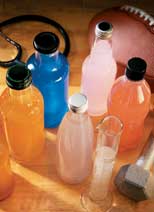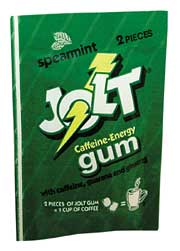
Different Goals, Different Formulas
Both sports and energy drinks do provide energy. A sports beverage, however, has the overriding goal of providing hydration to the consumer. If the carbohydrate content is too high, it may actually slow fluid absorption in the intestinal tract and lead to dehydration. Energy drinks, on the other hand, typically have a carbohydrate content dictated purely by organoleptic goals.How much is enough? A sports drink with less than 5% of carbohydrates is not optimal in providing performance-enhancing energy to the drinker's muscles and may shorten exercise duration. Levels above 10% overload the body's active transport mechanism, which, in turn, impedes fluid absorption. The optimum carbohydrate content for a sports drink is roughly in the range of 6% to 8% (14 to 19g) per 8-oz. serving.
In addition to different quantities of carbohydrates, sports and energy beverages also differ in the type of carbohydrate they contain. Generally, the most important aspect of their performance is the rate at which carbohydrates are digested and absorbed into the bloodstream, according to Ian Brown, senior director, nutrition, with an ingredient supplier.

Carbohydrates are necessary for maintaining muscle and liver glycogen levels during exercise. In the period prior to exercise (and also post-exercise, during recovery), complex carbohydrate-rich diets can be used to increase glycogen levels (and, hence, increase endurance). During exercise, however, the body requires more rapidly digested carbohydrates to replenish glycogen levels.
Glycogen levels most obviously are restored with glucose (dextrose). One way would be to add it in the form of either crystalline glucose, or high-glucose corn syrup.
Maltodextrins—often labeled as “glucose polymers” on sports beverages—are another option because they are digested very easily, and yield glucose almost as fast as glucose itself. Because they have a higher caloric density and a higher molecular weight than glucose, maltodextrins help keep the osmolality of the beverage similar to that of body fluids. This helps the body retain fluids where they are needed, rather than diverting them to aid digestion of the beverage. For sports beverages, the dextrose equivalent (DE) most commonly used is between 10 to 18 DE, with the higher DE maltodextrins offering greater clarity and lower viscosity.
Other carbohydrates yield glucose at varying times due to metabolic activity. Fructose and high-fructose corn syrup, for example, are more slowly isomerized to yield glucose. If used as a substantial portion of the carbohydrates, they may cause abdominal discomfort.

Beyond the Energy Source
“As a consequence, the formulators of foods for consumers interested in exercise need to be very careful that the form of the food or the other components of the food do not inhibit the digestion and absorption of carbohydrate or glucose,” explains Brown.In sports drinks, salts are important ingredients because they help replace the electrolytes (sodium and potassium) that the body loses through sweat. Typically, these are added in the form of sodium chloride and sodium or potassium salts of citric or phosphoric acid.
Also, when a body receives a certain volume of water, it may think it has enough fluid volume to replace what was lost through sweat and turn off the thirst mechanism. In actuality, it may not be hydrated. These salts encourage beverage consumption and, therefore, accelerate rehydration.
Added salts also make water more available to the tissues. Ideally, a sports drink should be formulated with a level of salts at an osmotic level equal to that of body fluids. The typical sweat concentration of sodium will range from 20 to 80 mmol/l. To mimic this, the sodium concentration of a sports drink should be around 20 mmol/l. Studies show that amounts greater than 60 mmol/l offer little rehydration advantage. Most sports beverages contain between 10 and 30 mmol/l of sodium.
Proteins Branch Out
Energy drinks may also contain amino acids. Research shows that the branched-chain amino acids leucine, isoleucine and valine help regulate serotonin production in the brain and allow extended athletic performance. At present, such studies are few in number, and the exact mechanism for this effect remains unknown. Nevertheless, high-level athletes who seek every potential advantage may look to amino acid content when they choose a sports beverage. Since endurance is a goal of energy drinks, one could argue for the inclusion of proteins, as most such products appear not to contain them.“For the recreational sports person, it's really different as far as composition, the complexity or the specific ingredients,” states Dale Olds, technical manager for product development at the National Food Laboratory Inc. (Dublin, Calif.). “Professional athletes may be looking for a specific amino acid profile and the electrolyte balance—things that may not even be needed by someone who won't get to the intensity of a professional workout.”
Soy and whey proteins both are potential sources of branched-chain amino acids. Each contains 18 to 26g of branched chain amino acids per 100g of protein.
“Whey is highest in branch chain amino acids, and it also has a really clean flavor for a lot of sports applications,” says Sharon Gerdes, a food technology consultant with Dairy Management Inc. (Rosemont, Ill.). “It works really well at lower pHs, which is another advantage in sports beverages and similar applications.”
Whey protein is processed either through ion exchange to yield a whey protein concentrate (WPC), or through ultrafiltration/microfiltration to yield a whey protein isolate (WPI). Although the exact protein composition differs, either will work in a beverage.
“If you wanted a very clear beverage, then you'd want to go with an isolate—it's lower in fat and would give you better clarity,” adds Gerdes. “Another reason to use an isolate is people want a very low level of lactose, and it is virtually lactose-free in the finished products.”
The solubility of whey proteins—which share the same coiled structure of other proteins—is affected by heat and pH. Processing temperatures above 155ÞF unravels these coils through denaturation, making the protein less soluble. Whey proteins also are the least soluble at their isoelectric point: 4.2 to 4.5pH for lactalbumin, and 5.3 to 5.5pH for lactoglobulin.
Nutrient Round-up
Although carbohydrates, select electrolytes and protein provide the primary benefits in sports and energy drinks, other ingredients—such as vitamins, stimulants and botanicals—also may be used.However, many nutrition experts see no need to include vitamins in sports drinks, as the body does not sweat them out. Still, some researchers suggest adding B-complex vitamins. Taken alone, they don't provide energy, per se, but are said to help release energy from carbohydrates. When adding B vitamins, it is important to be aware they can dramatically affect product flavor over time.
“B vitamins tend to go off, and you get that 'baby vitamin' note as the product ages,” says Julie Snarksi, an applications development scientist with a flavor manufacturer. “If you put in 20% of the daily value, you typically don't have problems. If you use levels higher than that, you're going to be getting all kinds of issues. If you go as high as 50% to 100% of the daily value, then it gets really challenging for us.”
Energy drinks often contain caffeine—an undesirable stimulant for sports drinks because it increases the heart rate and puts increased pressure on that organ. Caffeine and certain herbs also act as diuretics that could impede hydration goals.
In energy drinks, the direct connection to hydration and athletic performance is less of an issue. Consequently, they may contain caffeine, botanicals and a variety of additional vitamins—such as the antioxidant vitamins C, A and E. One popular botanical is guarana because it contains caffeine. Ginseng—prized for its revitalizing properties—also is commonly used in energy drinks.
Be sure to conduct real-time storage studies of products containing vitamins and botanicals. According to Snarski, the sludge that some beverages accumulate on their container bottoms often is connected to these ingredients. Because so many of these items are temperature sensitive, accelerated studies in elevated temperatures may not provide true results of how the product holds up under typical distribution conditions.
Although sports and energy beverages are similar, they possess key formulation differences. From carbohydrate composition to the inclusion of other ingredients, the goals of the end user guide the formulation of these products. A product that meets its goals properly is more likely to find its special niche in the sports and energy drink category.
Website Resources
www.naturalinvestor.com/nfm-online/nfm_backs/Jul_02/energydrink.cfm— Energy drinks and the natural foods marketwww.PreparedFoods.com/archives/2001/2001_6/0601science.htm — Formulating sports products, osmolality and ergogenic aids
www.runningtimes.com/issues/01julaug/gels.htm— General info. on sports and energy drinks